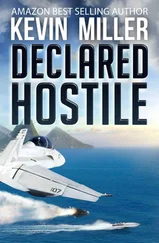An asphalt road, running from east to west, formed a distinctive black-on-sand visual cue of the Kuwait-Iraq border. Berms and lines of other man-made objects ran parallel to either side of the road. A great oilfield straddled the border, dominated by features of Iraq’s Ar Rumaylah complex: storage tanks, pipelines, various earthworks and the ever-present flare stacks. The stacks blazed through the midday haze and sent dark gray smoke aloft, where the prevailing winds carried it to the northeast. Underneath the smoke were large swaths of black, oil-stained sand. From Wilson’s vantage point five miles above, the swaths looked like giant ink spills on the desert floor. Though far from human settlements, environmental considerations were not high priorities on this bleak landscape.
Wilson shifted in his seat. Yesterday, Shakey and Dutch had dropped two GPS-guided Joint Direct Attack Munitions apiece on an insurgent stronghold in western Diyala north of Baghdad. They were the first weapons CVW-4 had released in a week, and the Air Force had done some “good work,” too. Before he had walked, he learned the Spartans and Moonshadows had released on targets in Diyala that morning. Wilson’s two-plane “section” carried a mixed load of two 500-pound JDAM and two LGBs split between them. Each also carried several hundred rounds of 20mm. Wilson wished he had a Maverick missile to shoot at a vehicle or something moving. He had never had the opportunity to shoot one before. Positioning himself more comfortably, he settled in for the next 200 miles to Padres .
After 15 minutes of looking at the brown countryside of southern Iraq, the airspace controller broke the silence. “ Nail four-one, switch up Exxon five-five on Violet three.”
Wilson keyed the mike and replied, “ Nail four-one, roger. Switching Exxon five-five on Violet three. Nails go.”
“Two,” Smoke acknowledged.
His radar swept back and forth in the 80-mile scale. Wilson picked up a contact in the top half of his display and bumped the castle switch to the right. The cursor went to the contact and locked it, showing an airborne contact 10 degrees left of the nose at 24,000 feet heading east. On the left display his FLIR showed the bogey as a white image, which to Wilson’s trained eye was a KC-135 Stratotanker , call sign Exxon 55 . In his HUD was displayed a course to intercept, but Wilson ignored it, knowing that the tanker would begin the racetrack turn to the west before long.
Minutes later, when the tanker turned, Wilson set an intercept course to the northwest, listening to two Buccaneers line up behind Exxon 55 for a long drink. Through his FLIR, he discerned two white dots behind the tanker. Raising his head, he could see with his naked eye a small dash set against a lone cumulonimbus cloud 30 miles away on the northern horizon, with two tiny dots behind it.
The boom operator called to one of the Hornet s. “Three-zero-seven, that was 7,200.”
“Three-zero-seven, roger.” Wilson recognized the voice of one of the VFA-47 JOs.
Sliding closer, Wilson positioned them on the tanker’s left wing, using geometry to close the distance. Inside 10 miles he could discern the tanker aspect, and hoped they would hold this heading to affect an expeditious join up. He wasn’t in too much of a hurry. The second jet had just plugged, and 8,000 pounds took eight minutes.
Soon Wilson joined up on the left wing of the gray 707 airframe using visual cues, while Cutlass 310 was still plugged in on the boom. Smoke drew in closer in a loose cruise, and using hand signals, informed Wilson of his fuel state — 5.7. Wilson gave a thumbs up and passed his own state — 5.9 — with an open hand (five) followed by four horizontal fingers (nine).
As 310 backed out with a small puff of fuel vapor over his fuselage, the basket swung like a mace in the relative wind before it steadied. The boomer radioed 310 that he had taken 9,000 pounds, and 310 crossed under to the outside of his own wingman.
Wilson called, “ Exxon five-five, Nail four-one flight joined on your left wing as fragged, nose cold, switches safe.” He took a glance over his left shoulder at Smoke, who nodded an acknowledgement.
“Roger, Nails , cleared precontact,” the boom operator replied.
“Roger, precontact,” Wilson answered. He then reached down with his left hand to extend the air refueling probe, which extended into the airstream from his right nose.
In a practiced motion, he dropped his right wing and pulled a bit of power, gliding back to a position behind the boom. For a few moments, the five aircraft flew as one at 300 knots. However, as Wilson drew closer to the basket, the Buccaneer section banked right and opened away from the formation at a measured clip. Wilson noticed their weapons were still secured under their wings, weapons they would take home with them on the one-hour return flight to the ship.
When he lined up the probe five feet behind the basket and stabilized, he could make out the face of the boom operator. The “boomer” wore sunglasses and headphones as he watched Wilson from a window on the bottom of the fuselage.
“Precontact,” Wilson transmitted.
“Cleared contact,” the boomer replied.
The tanker then began a right turn to remain on the track, and Wilson compensated by matching the roll and adding a bit of power. As his probe inched closer to the basket, Wilson maneuvered his aircraft with tight deflections of the stick. Satisfied with the angle, Wilson added a little power and flew his probe into the basket, then took a bit off to cause the six-foot hose to bend a little, but not too much.
“Contact.”
Fuel flowed into the aircraft while they completed the turn to the right and rolled wings level. Wilson concentrated to keep the probe engaged with the basket. For the next eight minutes he maintained this position by holding the aircraft within an area no more than three feet square, down and to the left of the tanker. Fuel transferred through this connection filling his internal tanks and centerline drop. Wilson made his corrections to stay engaged almost by reflex. This allowed his mind to speculate on where, and for what purpose, Falcon , or the CAOC airborne coordination controllers, would send them once refueling was complete.
Once transfer was complete, he was careful to get aligned with the end of the rigid steel boom as he slid aft to unplug. The basket came off the probe with a little whip motion and then steadied out into the relative airstream. Wilson waved thanks to the boomer and retracted the probe, sliding over to the tanker’s right wing.
“Four-zero-seven. That’s 8,400.”
“Roger, eight-point-four,” Wilson replied and scribbled 8.4 on his kneeboard card.
While Smoke went through the same procedure, Wilson was able to relax a bit on the right wing and study the tanker. Painted a dark shade of gray with a black nose, it had four fat turbofan engines on the wings. At the top of the tail the word “MISSISSIPPI” was spelled with large interlocking “Ss,” the style common to the state’s promotional literature. Wilson knew this Air National Guard refueling squadron was based at Key Field in Meridian, just across town from where Wilson had gone to flight school 12 years earlier. He pulled acute to the cockpit, some 60 feet away, and saw that the copilot was looking at him. The pilot next to him then popped his head into view. When another face appeared in the window behind the copilot, Wilson gave them a thumbs-up, which the three Air Guard aircrew returned. The copilot pointed at the ordnance under the Hornet’s wing and slammed his right fist into his left palm, then bared his teeth and flexed two clenched fists in front of his face. The message was unmistakable, and Wilson nodded an acknowledgment.
Читать дальше












